
Recently, several pharmacy students had the opportunity to wear glucose monitors for their elective course, Diabetes Experience.
Pharmacy students wear glucose monitors for elective course
It’s important for pharmacists to understand the technology they dispense to their patients. Pharmacists need to be able to answer the questions their patients bring up, or at least direct them to the right resource. Connecting with patients on a human level requires empathy.
Concordia University Wisconsin’s School of Pharmacy students recently participated in an exercise of both technological skill and empathy. Dr. Beth Buckley teaches a course on diabetes experience, where she required her students to wear two continuous glucose monitors in order to learn the technology, collect and analyze data, and build their empathy. Read more about it below.
Note: Dr. Buckley’s responses are typed in italics.
What is the purpose of this experience?
We wanted to incorporate the use of continuous glucose monitoring (CGM) technology within the one-credit Diabetes Experience Elective course. Our students had the opportunity to experience the sensors themselves. They wore the sensors for up to two weeks, collected ongoing, real-time data from them, and then interpreted that data in order to improve their own food choices, exercise, and goal-setting.
One of the most important concepts students learned was how to interpret and assess glucose monitor technology. Additionally, they learned to troubleshoot and how to make real-time recommendations regarding different aspect of diabetes care (diet, exercise, medication, patient education).
What’s the purpose of this course?
The Diabetes Experience one-credit course helps expand the third-year pharmacy student’s knowledge base. Also, students will build empathy and grow in their ability to effectively work with diabetes patients. This course provides hands-on learning and personal experiences with the cornerstones of diabetes management. It’s an advanced course, so these advanced clinical skills go above and beyond what is included in the curriculum. This valuable experience sets Concordia apart from other programs.
Why is this especially helpful for pharmacy students?
This education not only benefits our students, but beyond. As our students join the workforce with this advanced skillset, they’ll get to train others in the pharmacy profession at large. Their future patients will reap the benefits as well.
Practicing using glucose monitors bridges a gap
Additionally, pharmacy students need to individualize the technology they prescribe their patients. This means considering the patient’s needs, desires, skill level, and the availability of devices. Continuous glucose monitors are available through the pharmacy. But, most pharmacists don’t have the opportunity to learn about these glucose monitors during pharmacy school. This course and specifically, this experience, helps to bridge that gap.
In order for pharmacists to comply with this standard, they’ll need to know how to assess and trouble shoot the use of CGM technology. Technology is best learned through personal, hands-on use. Simply reading about the sensors, readers, and reports doesn’t allow the same depth of knowledge that comes from hands-on use.
What made it possible for you to provide this opportunity for your students?
An internal grant focused on innovation and research within the School of Pharmacy, made this possible. The sensors are expensive, so this isn’t usually a part of student learning in pharmacy school. Concordia is able to provide this advanced level of innovation and skill level attainment to our pharmacy students due to the generosity of donations.
Do you want to know more?
Are you interested in learning more about Concordia University Wisconsin’s School of Pharmacy? Visit us here.
—
If this story has inspired you, why not explore how you can help further Concordia's mission through giving.